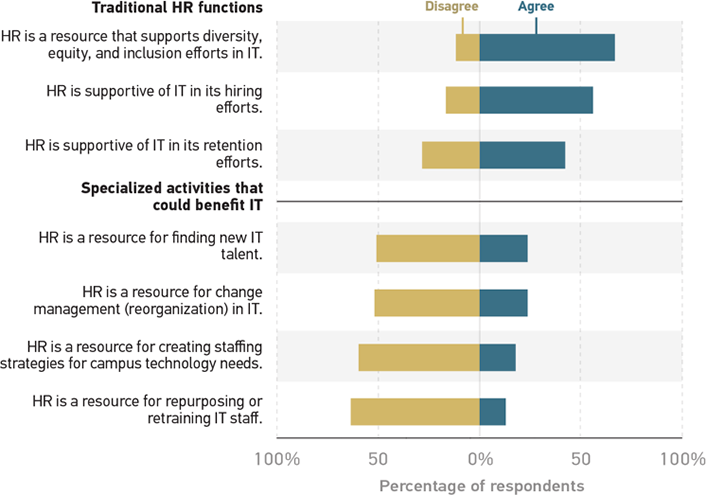Higher education information technology and human resources departments can both benefit from increased collaboration and communication.

Since 2013, EDUCAUSE has been surveying higher education IT managers and CIOs about the resources and support that human resources (HR) provides to help IT units effectively and nimbly meet staffing needs. The results of these surveys have produced consistent and consistently ambivalent results. When it comes to basic, general functions to support hiring and retention efforts, HR receives relatively high marks. For example, a little more than half of IT professionals agreed that HR has been supportive of IT's hiring efforts in the past five years: 48% in 2014; 54% in 2016; and 57% in 2019 (see figure 1). A majority of IT managers and CIOs view central HR as a resource that supports diversity, equity, and inclusion (DEI) efforts. HR is considered to be supportive of IT retention efforts as well.

However, IT professionals continue to rate the support that HR provides for specialized activities related to IT comparatively lower than they rate the support HR provides for general activities. Indeed, a majority of higher education IT managers and CIOs report that HR is not a resource for finding new IT talent, managing change, creating staffing strategies for campus technology needs, or repurposing or retraining IT staff. Unfortunately, it has been this way for several years, despite calls for HR to reach out to IT, and vice versa, to improve their relationship.1 Rather than continuing to make general appeals to HR or IT units to work on improving support for specialized IT needs, we—as the directors of research for our respective professional organizations (CUPA-HR and EDUCAUSE)—are taking a different approach this year. We are leveraging our combined resources on the subject and on our capacities to reach both audiences to offer some clear recommendations (or at least first steps) for how to foment a better relationship between HR and IT.
While IT certainly needs to draw upon the basic services offered by HR units, IT does in fact have some specialized needs that do not neatly or clearly fall into the parameters defined by non-IT staff, faculty, or administrators. The world of IT beyond the gates of the institution changes rapidly, and the higher education IT workforce needs to be able to rapidly adapt to that world. Today's higher education IT organizations face a host of challenges: they are responding to technological innovations, succumbing to pressures to outsource services and applications, and confronting the need to provide and manage services in new ways. For higher education IT, it feels as if the only constant is change.
One consequence of the constantly changing nature of IT units is that their staffing structures and needs are also constantly in flux. HR can help to mitigate the instability that normally accompanies such changes by doing the following:
- Understand IT's needs for new talent. Have regular discussions with IT regarding changes that are on the horizon. Ask about what new skills IT units need to accommodate these changes.
- Help IT locate new talent. Discuss whether searches for new talent need to be performed locally, regionally, or nationally. Collaborate with IT in developing an action plan for where you will advertise new positions.
- Help IT develop new skills within existing staff. Identify staff whose skills may be outdated and would benefit from training in a new area.
- Accommodate the need for IT to change its staffing structure on a semi-regular basis. Understand that the requirement to address the IT needs of an entire organization will necessitate shifts in how IT units structure their department(s) and leadership.
- Help IT use market data to establish salaries, salary increases, and staffing structures that follow trends of peer institutions and competing industries. Discuss the importance of remaining competitive in the local labor market for the purpose of retaining good talent.
The great thing about increased collaboration between HR and IT is that it's not a one-way street. HR can benefit from increased collaboration with IT in important ways.
- Use of technology. HR leaders already partner with IT to use technology to streamline and make processes more efficient, but this must be an ongoing collaboration as work changes and as the needs of the institution and the institution's workforce change. IT can help HR evaluate workflow and use technology to minimize or eliminate manual processes. In addition, IT can help HR develop more mobile-enabled and just-in-time services to support changing employee needs and expectations.
- Data and analytics. Anecdotally, many HR professionals feel their department is underdeveloped in its analytics endeavors. HR professionals want to use data more for strategic decision-making, but they don't know how to get started. IT professionals can help their HR colleagues evaluate data sources; build, maintain, and query databases; develop dashboards for leadership; and evaluate and select vendors for outsourced services.
- DEI efforts. IT departments are striving to increase diversity and ensure pay equity, as well as strengthen their pipeline to promote women and minorities into leadership positions. The leadership of both EDUCAUSE and CUPA-HR are engaged in ongoing collaborative efforts to develop action steps to make progress in DEI efforts. HR leaders who are looking for a place to develop their DEI efforts may find willing collaborators in their IT department.
- Change management. Just as technology is rapidly evolving and changing, so too is the work of IT departments. HR can apply the lessons learned from its increased collaboration with IT to more quickly adapt position duties, needed competencies, and training and development needs to other parts of the institution. It also positions HR to better support recruitment and retention of IT staff.
It is our hope that these recommendations and shared goals will motivate IT and HR professionals to take first (or second or third) steps in communicating their needs, discussing how they might help each other succeed, and building an ongoing relationship of mutual support. There is much to be gained from an HR/IT partnership. As an IT or HR professional, ask yourself what you can do to build this relationship, and get started!
- Choose a goal you wish to achieve for your department, and ask for help.
- Set up formal discussions in which you build step-by-step plans to achieve these goals.
- Follow up and follow through to identify areas of progress and areas that need further work.
- Celebrate accomplishments, both within your departments and throughout your institution.
These steps build social capital that can lead to strong partnerships, bolster leadership skills, and allow both HR and IT to better focus on the big-picture needs of their respective departments. In our estimation, a strong IT/HR relationship can be nothing but a win-win situation for both sides.
Learn More
Access additional materials at The IT Workforce in Higher Education, 2019: CIOs, DEI, HR, Mentoring, and Salaries.
Note
- Jacqueline Bichsel, Today's Higher Education IT Workforce, research report (Louisville, CO: EDUCAUSE, January 2014); Jeffrey Pomerantz and D. Christopher Brooks, The Higher Education IT Workforce Landscape Report, 2016, research report (Louisville, CO: EDUCAUSE, April 2016). ↩
D. Christopher Brooks is Director of Research at EDUCAUSE.
Jacqueline Bichsel is Director of Research at CUPA-HR.
© 2019 D. Christopher Brooks and Jacqueline Bichsel. The text of this work is licensed under a Creative Commons BY-NC-ND 4.0 International License.

